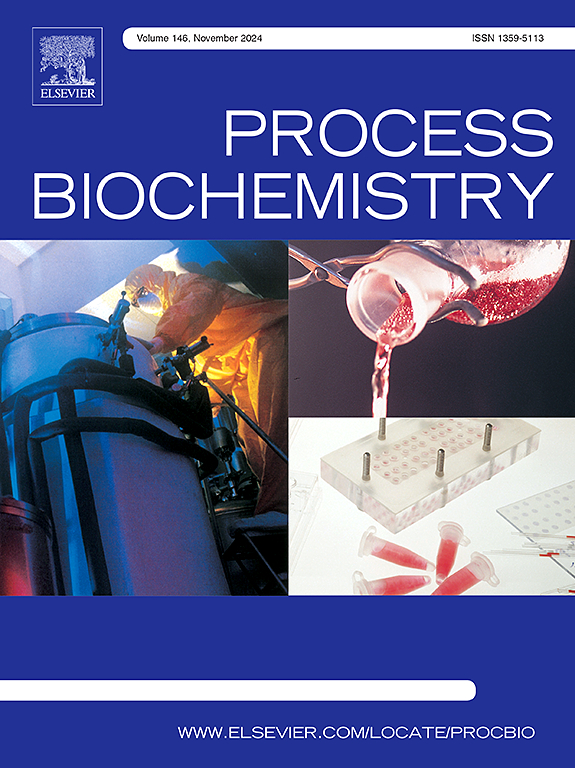Fluorescence excitation-emission matrix combined with chemometric modelling for upstream monitoring of SARS-CoV-2 spike protein production
IF 4
3区 生物学
Q2 BIOCHEMISTRY & MOLECULAR BIOLOGY
引用次数: 0
Abstract
Biotherapeutic production is inherently complex, requiring multiple unit operations and analytical methods compared to small-molecule drugs. In this context, Quality by Design (QbD) and Process Analytical Technology (PAT) play key roles in ensuring the quality, safety, and efficacy of biotherapeutics. This work presents a fluorescence excitation-emission matrix (EEM) combined with PARAFAC (Parallel Factor) model under non-negativity constraint for the off-line quantitative prediction of the SARS-CoV-2 Spike ectodomain glycoprotein (S-ED), a COVID-19 subunit vaccine candidate, in HEK293 perfusion bioreactor cultures. Design of experiments (DoE) approach was applied to optimize the sandwich enzyme-linked immunosorbent assay (ELISA) method, whose validation was crucial to assess the accuracy and consistency of the results. Principal component analysis (PCA) was used for outlier detection in spectral data, while an appropriate chemical rank estimation strategy was implemented to determine the number of fluorescent responsive components. Subsequently, PARAFAC modelling of the three-way data array enabled the off-line prediction of S-ED in bioreactor samples. This multivariate calibration model, offering simplicity, accuracy, and precision, aligns with PAT guidelines by monitoring critical process parameters (CPPs) such as S-ED concentration in bioreactor samples. It provides an efficient alternative to traditional analytical methods, enhancing process monitoring and improving the overall S-ED production workflow.
荧光激发-发射矩阵结合化学计量模型用于SARS-CoV-2刺突蛋白生产的上游监测
与小分子药物相比,生物治疗生产本身就很复杂,需要多个单元操作和分析方法。在这种情况下,设计质量(QbD)和过程分析技术(PAT)在确保生物治疗药物的质量、安全性和有效性方面发挥着关键作用。本研究提出了一种非负性约束下的荧光激发-发射矩阵(EEM)结合平行因子(PARAFAC)模型,用于离线定量预测HEK293灌注生物反应器培养物中COVID-19亚单位候选疫苗SARS-CoV-2刺突外结构域糖蛋白(S-ED)。采用实验设计(DoE)方法对夹心酶联免疫吸附测定(ELISA)方法进行优化,该方法的验证对评估结果的准确性和一致性至关重要。采用主成分分析(PCA)对光谱数据进行异常值检测,并采用适当的化学等级估计策略确定荧光响应成分的数量。随后,PARAFAC对三向数据阵列进行建模,实现了生物反应器样品中S-ED的离线预测。这种多变量校准模型通过监测生物反应器样品中的S-ED浓度等关键过程参数(CPPs),符合PAT指南,提供简单、准确和精密。它提供了传统分析方法的有效替代方案,增强了过程监控并改善了整个S-ED生产工作流程。
本文章由计算机程序翻译,如有差异,请以英文原文为准。
求助全文
约1分钟内获得全文
求助全文
来源期刊

Process Biochemistry
生物-工程:化工
CiteScore
8.30
自引率
4.50%
发文量
374
审稿时长
53 days
期刊介绍:
Process Biochemistry is an application-orientated research journal devoted to reporting advances with originality and novelty, in the science and technology of the processes involving bioactive molecules and living organisms. These processes concern the production of useful metabolites or materials, or the removal of toxic compounds using tools and methods of current biology and engineering. Its main areas of interest include novel bioprocesses and enabling technologies (such as nanobiotechnology, tissue engineering, directed evolution, metabolic engineering, systems biology, and synthetic biology) applicable in food (nutraceutical), healthcare (medical, pharmaceutical, cosmetic), energy (biofuels), environmental, and biorefinery industries and their underlying biological and engineering principles.
 求助内容:
求助内容: 应助结果提醒方式:
应助结果提醒方式:


